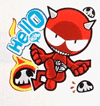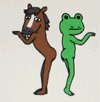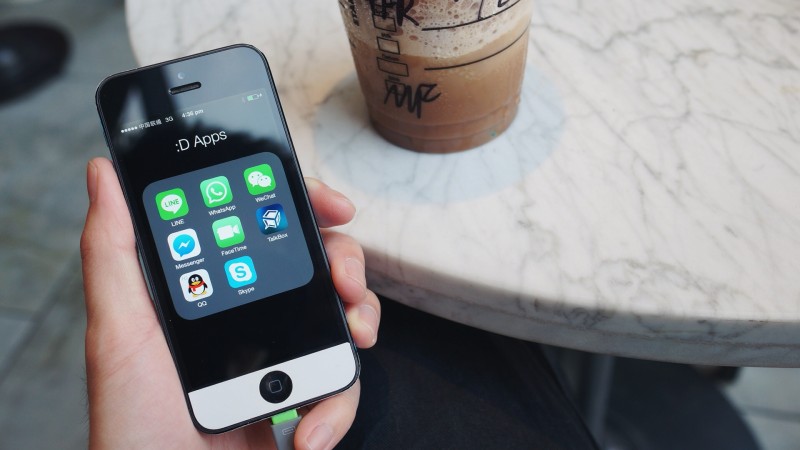Below is an edited version of the post “The Sticker Wars: WeChat’s creatives go up against Line” by Jason Li, originally published on the blog 88 Bar.
Words don't always cut it on mobile messaging apps. That's when a well-chosen emoticon can come in handy, and these days there are certainly plenty to choose from.
Emoticons aren't only good for conversation — they're good for business. Japanese chat app Line has discovered a booming revenue model selling different sets of stickers, which are essentially more detailed emoticons. Other chat apps like South Korean KakaoTalk and Canadian Kik have quickly caught on and implemented their own versions of stickers.
Not to be left behind, China's immensely popular WeChat has also jumped on the sticker trend. But are their stickers as good as Line's? Let's take a look.
Line, distinctly Japanese
Line’s core selection of stickers is full of cute characters, stark expressions, and plenty of comical situations just vague enough to apply to whatever situation might come up in a conversation. I myself have bought nine sticker sets to date on top of using a dozen or so free ones.
They are also distinctly Japanese — the art style is very clean, people and creatures have large heads, and the expressions are based on Japanese manga conventions.
One of the most popular stickers involves the love story between a bear and a bunny, mirroring stereotypical East Asian male-female relationship dynamics. Note the stoic male character versus the shopaholic and emotionally effusive female character.
Not only has Line created a great set of their own stickers, but they've managed to rope in some of Japan’s most popular cartoon characters – Hello Kitty, Doraemon, Dragon Ball – as well as some from the United States – Spongebob SquarePants, Donald Duck, Snoopy. Line also runs many time-limited promotions, such as their “Pray for the Philippines” stickers following last year's devastating typhoon (the proceeds were donated to help the victims).
Line is now testing the waters with their first animated sticker pack launched on June 12 featuring their core characters.
WeChat, wacky and weird in its own way
At first, it seemed that WeChat’s sole innovation was that its stickers were animated. All the animations below have been reproduced by hand as GIFs, but the actual stickers contain much smoother animation.
When it was launched, the company had already licensed the now Turner-owned Tuzki line of emoticons that were all the rage on the Chinese Internet about 5-10 years ago:

Tuzki
But aside from Tuzki, their initial sticker packs felt somewhat weaker. Some resembled Line’s Japanese creations but without the punch:

Nervous Boy by Caerux
While others had a flat, commercial personality:

DADA by 2SPOT
More importantly, these sticker sets did not capture the nuanced emotions and complex backstories that are the hallmark of a Line sticker and that make it a great conversational lubricant.
But recently, WeChat’s stickers have started to develop a style of their own. The packs are great not because they try to mimic the polished “Hello Kitty” Line style, but because they’re wacky, weird and funny in their own way. There’s a very Chinese flavor to them — the grainy lines, absurd sense of humor and adult style are reminiscent of the kind of illustration and design coming out of China today.

Frog and Horse by XiaoYaoJi
The stickers themselves aren't always created in mainland China. Many are from Hong Kong (Old Girl, Fatina, AH FEI@GAL) or Taiwan (Sinkcomic); some are even Japanese acquisitions, though they aren’t as clean and cute as the Line products.

AH FEI@GAL by Graphic Airlines
Through conversations within our group, we noticed that WeChat offers different sets of stickers in their store depending on where you live. So the stickers here may disproportionately represent Hong Kong, where I'm based. Right now, this geographic targeting seems minor as the majority of the stickers seem to be offered to both people living in Hong Kong and the U.S. (our two test cases).
It’s still too early to tell whether WeChat’s sticker system will continue to evolve. But as it stands, WeChat is already catching up to Line and jumping ahead of its other competitors.










7 comments
I hear Line and Kakaotalk are currently blocked on the mainland.
Then why dont you use Photo4tune. Its better app. And its for android phone. It can be downloaded from Google Play Store.
Use your smartphone in bed while in comfort with this great phone holder that magically floats your phone by your bed without bolts or clips. Now on sale at Amazon http://www.amazon.com/gp/product/B0074U2MAK .
I heard this new chat app by the name Photo4tune has unleashed awesome Premium stickers and emoticons so very cute for FREE unlike the other chat apps! Has anyone tried it so far? https://play.google.com/store/apps/details?id=com.photo4tune.navigator
Hey Guys
Unfortunately, you can not sell your stickers on any IM apps directly till now.
Only Line app has creator’s sticker market :
https://store.line.me/stickersho…
you can sell every sticker that approve by Line, like this :
https://store.line.me/stickershop/product/1183924/en